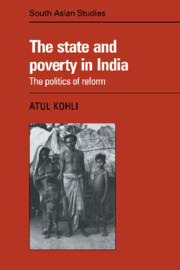Book contents
- Frontmatter
- Contents
- List of Tables and Figures
- Acknowledgements
- Introduction
- 1 The State and Redistributive Reforms
- 2 Democracy and Development in India: an Interpretation
- 3 West Bengal: Parliamentary Communism and Reform from above
- 4 Karnataka: Populism, Patronage, and Piecemeal Reform
- 5 Uttar Pradesh: Political Fragmentation, Middle-Peasant Dominance, and the Neglect of Reforms
- 6 Conclusion: The State and Reform in Democratic–Capitalist Development
- Appendix I On the Political Relevance of Social Classes in a Developmental Setting
- Appendix II Does Agriculture Growth Really “Trickle-down” in India?
- Bibliography
- Index
- CAMBRIDGE SOUTH ASIAN STUDIES
3 - West Bengal: Parliamentary Communism and Reform from above
Published online by Cambridge University Press: 27 October 2009
- Frontmatter
- Contents
- List of Tables and Figures
- Acknowledgements
- Introduction
- 1 The State and Redistributive Reforms
- 2 Democracy and Development in India: an Interpretation
- 3 West Bengal: Parliamentary Communism and Reform from above
- 4 Karnataka: Populism, Patronage, and Piecemeal Reform
- 5 Uttar Pradesh: Political Fragmentation, Middle-Peasant Dominance, and the Neglect of Reforms
- 6 Conclusion: The State and Reform in Democratic–Capitalist Development
- Appendix I On the Political Relevance of Social Classes in a Developmental Setting
- Appendix II Does Agriculture Growth Really “Trickle-down” in India?
- Bibliography
- Index
- CAMBRIDGE SOUTH ASIAN STUDIES
Summary
The Communist Party of India, Marxist (CPM) returned to power in West Bengal in 1977. This time, unlike the previous United Front Ministries, the CPM had a clear majority. Alone it won 177 of the 293 assembly seats; along with its partners in the Left Front, the CPM now controlled a solid majority of 230 seats. The 1982 elections further confirmed the CPM's electoral popularity within West Bengal. These “parliamentary communists” have since 1977 sought to translate their power into developmental change. Central to their overall strategy is a concerted attack on the rural poverty of West Bengal. The creation of “red” panchayats (local governments), the registration of sharecroppers, the facilitation of credit for small landholders, and the mobilization of the landless for higher wages are all aimed at securing political position by improving the conditions of the lower classes. Whereas many others in India have paid lip-service to these redistributive goals, the CPM alone has made systematic and impressive beginnings towards accomplishing them. This is not to suggest that the CPM regime is without its share of failings, problems, and critics. The CPM's redistributive programs are nevertheless impressive. If sustained, they promise to have a significant long-term impact on the living conditions of the rural poor.
What is it that distinguishes the CPM regime of West Bengal and its developmental efforts from other ruling parties in Indian states? To answer this, I will analyze below the nature of the CPM as a ruling party and its distributional policies.
- Type
- Chapter
- Information
- The State and Poverty in India , pp. 94 - 143Publisher: Cambridge University PressPrint publication year: 1987

